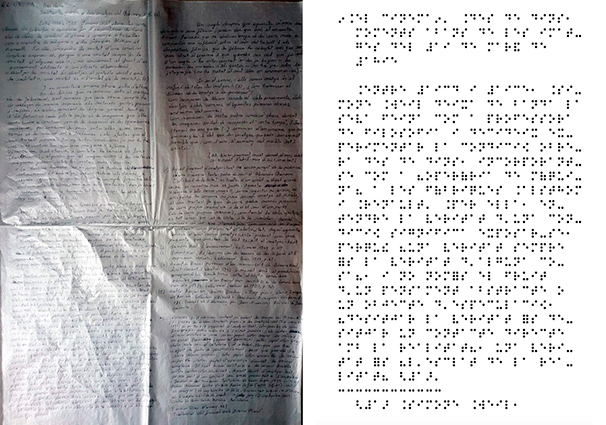What are you looking for?
You might be looking for...
EL CINEMA. Des de dins. Instants previs a las imatges del 19 de març de 1895
Alejandra Riera

Obra
«If in dreams that which is "imageless is the refuge of all images”, (W.B.) how do we cross the threshold of the image and its possession? How do we rediscover the freely circulating thoughts, desires, and dreams of the first anonymous film workers? How do we recognize our own working conditions in the face of the present century’s machines and devices, in order to reclaim our own free time, the only time we have left? And to dream of a frameless cinema whose images offer a possibility that, like the air, escapes the visible and yet still exists as such.
Five photographs printed on glass make the first female cinema workers visible from inside the Lumière factory in France. A text handwritten in Catalan, Spanish, English, and translated into Braille, accompanied the images. The piece dialogue with a “camera-wood-river stone” made by Alexandre Chanoine, [from the artist’s collection], which consists of a stone attached to a wooden sound box. This imageless camera, without a capacity to record and store, does not register, preserve, or fix the visible in any visual shape or form. Its enigma infers that its stone alone safeguards its memory and that of the river from which it originated (in its own way). Like the movement of anyone who chooses to turn its handle, it too produces an amplified sound like an echo in space without the need for electricity. This “imageless camera” is present here in the form of a question about the possible, which pursues that of the interweaving of the images-text». A. R., translated by Dean Inkstern
EL CINE. From the Inside. Moments Before the Moving Images of March 19, 1895
2022-2023. Alejandra Riera. To the left detail of the manuscript in Catalan, on the right, detail of the braille version part of the work. Photograph courtesy of the artist.
Captions of the photographs from archives of the Institute Lumière:
- The caption reads: “Workshop for cutting and sorting glass plates, circa 1895, Lumière factories, Montpellier (Lyon), Institut Lumière".
- Two women sorting through broken glass, setting aside pieces at least 8 centimeters in size or more, as indicated by the sign behind them, while discarding the rest, Lumière factories, Monplaisir (Lyon). The caption reads: “Sorting broken glass, circa 1895, Lumière factories, Montpellier (Lyon), Institut Lumière”.
- A woman treats the hands of a worker injured either during the cutting of glass plates or sorting through broken glass. The caption reads: “The medical service of the Lumière factory, circa 1895, Lumière factories, Montpellier (Lyon), Institut Lumière".
- A woman preparing chemical emulsions. Functioning like a sewing machine, the cinematograph loaded film stock intermittently and more slowly (16 frames per second) than the kinetoscope (46 frames per second); it made less noise and the images appeared more fluidly on the screen. It thus allowed for a large audience to attend the projection, unlike Edison’s kinetoscope which only allowed for an individual spectator at a time who paid to turn a wheel-like handle while watching an animated image through a lens. Paying to see images heralded the beginnings of the film industry. The cinematograph was a lighter, more portable camera.
- The caption reads: “Workshop for the preparation and development of emulsions, Lumière factories, circa 1895".
Alejandra Riera taught cinema and documentary practice for eleven years at the École nationale supérieure d'art de Bourges where she ran the “manières de faire” (ways of doing) [workshop : Peut-on l’appeler un workshop ?]. She currently teaches art, transversal poetics and documentary practice at the École nationale supérieure d'arts de Cergy in France.
Her work—which she prefers to call “tentatives” (endeavors) — employs photography and cinema in their relation with writing and history. Her work, writings, and film-documents are undertaken both in thought and practice with various spaces and collectives which, each time, reveal themselves to be unique. Her poetic opens ways in which fragile and organic worlds – often silent – find the context in which they can express themselves. In recent years, she has instigated, organized, and maintained the physical transformation from reality to perception of various places, working alone and collectively, in order to encourage the expression, respect, and mutual aid between humans and non-humans. Her “endeavors” have been presented both inside and outside the traditional spaces dedicated to the production and display of art. In 2022, the MNCARS in Madrid exhibited a substantial part of her archives in the exhibition < Jardin des Mixtures. Attempts to make place. 1999 - … >.
